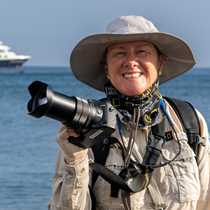Palouse River
Lower Granite lock and dam were left behind at dawn. We have begun our return journey down the Snake River, heading west. At this time of year almost exactly 200 years ago to the day, Lewis and Clark traveled here on their own journey to the western sea. The lake created by Lower Monumental dam allowed the Sea Bird to drop anchor in roughly 26 feet of water, just inside the mouth of the Palouse River. In Lewis and Clark’s time, the river was only a smallish, shallow run below where we are anchored today. They named it “Drewyer’s River,” after Corps member George Drouillard.
For our purposes, the Palouse provided ideal conditions for Zodiac cruising and kayaking. At first the chill air had us disembarking with jackets and sweaters. However, mid-way through the morning we shed these layers and soaked up the sun as we explored the river as far up-stream as was feasible by Zodiac, paddled quietly into by-ways over-hung with cattails and willows, or gazed down over the cliff-edges at Palouse Falls, six miles away from our anchorage.
On return to the Sea Bird a barbecue lunch was waiting for us on the top deck, which as we weighed anchor and made a turn into the Snake River allowed us to enjoy and watch with eyes wide this impressive scenery. Our passage through Lower Monumental Lock and Dam was exciting, and segued into a serene cruise through the dramatic Palouse scablands for the rest of the sunny afternoon.
Our historian, Jerry Igo, introduced us to Patrick Gass a bit later. Patrick is the only member of the Corps of Discovery to live into his 90’s. His published journal provided the perfect platform from which to hear of the Corps of Discovery’s exploration west, as well as to find out what happened to all the members (as he out-lived them all). Through his eyes, we relived the past, though soon started to anticipate the future, as tomorrow holds more adventures further down river.
Lower Granite lock and dam were left behind at dawn. We have begun our return journey down the Snake River, heading west. At this time of year almost exactly 200 years ago to the day, Lewis and Clark traveled here on their own journey to the western sea. The lake created by Lower Monumental dam allowed the Sea Bird to drop anchor in roughly 26 feet of water, just inside the mouth of the Palouse River. In Lewis and Clark’s time, the river was only a smallish, shallow run below where we are anchored today. They named it “Drewyer’s River,” after Corps member George Drouillard.
For our purposes, the Palouse provided ideal conditions for Zodiac cruising and kayaking. At first the chill air had us disembarking with jackets and sweaters. However, mid-way through the morning we shed these layers and soaked up the sun as we explored the river as far up-stream as was feasible by Zodiac, paddled quietly into by-ways over-hung with cattails and willows, or gazed down over the cliff-edges at Palouse Falls, six miles away from our anchorage.
On return to the Sea Bird a barbecue lunch was waiting for us on the top deck, which as we weighed anchor and made a turn into the Snake River allowed us to enjoy and watch with eyes wide this impressive scenery. Our passage through Lower Monumental Lock and Dam was exciting, and segued into a serene cruise through the dramatic Palouse scablands for the rest of the sunny afternoon.
Our historian, Jerry Igo, introduced us to Patrick Gass a bit later. Patrick is the only member of the Corps of Discovery to live into his 90’s. His published journal provided the perfect platform from which to hear of the Corps of Discovery’s exploration west, as well as to find out what happened to all the members (as he out-lived them all). Through his eyes, we relived the past, though soon started to anticipate the future, as tomorrow holds more adventures further down river.




